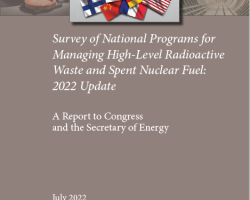Category of Content
Siting Experience Documents Only
Publication Date
Subject Matter
Embrittlement and DBTT of HighBurnup PWR Fuel Cladding Alloys
Embrittlement and DBTT of HighBurnup PWR Fuel Cladding Alloys
Instrumentation: Nondestructive Examination for Verification of Canister and Cladding Integrity – FY2014 Status Update
Instrumentation: Nondestructive Examination for Verification of Canister and Cladding Integrity – FY2014 Status Update
Technical Report on the Status of Nonlinear Ultrasonic Techniques for Non-Destructive Inspection
Technical Report on the Status of Nonlinear Ultrasonic Techniques for Non-Destructive Inspection
Status Update- Deposition Modeling For SNF Canister CISCC
Status Update- Deposition Modeling For SNF Canister CISCC
M3SF-21SN010207057- FY21 Status Report- Probabilistic SCC Model for SNF Dry Storage Canisters
M3SF-21SN010207057- FY21 Status Report- Probabilistic SCC Model for SNF Dry Storage Canisters
Update on Investigations of Viability of Cold Spray and FSW as a Spent Nuclear Fuel Dry Storage Canister Mitigation Tool
Update on Investigations of Viability of Cold Spray and FSW as a Spent Nuclear Fuel Dry Storage Canister Mitigation Tool
Guidance for Creating a Community Benefits Plan for Regional Direct Air Capture Hubs
Guidance for Creating a Community Benefits Plan for Regional Direct Air Capture Hubs
This document is intended to provide supplemental information to assist applicants developing a Community Benefits Plan (CBP) for the Regional Direct Air Capture Hubs. As shown in the graphic to the right, Community Benefits Plans are based on a set of four core interdependent policy priorities: engaging communities and labor; investing in America's workforce; advancing diversity, equity, inclusion, and accessibility; and implementing Justice40.
Policies for Achieving Energy Justice in Society: Best Practices for Applying Solar Energy Technologies to Low-Income Housing
Policies for Achieving Energy Justice in Society: Best Practices for Applying Solar Energy Technologies to Low-Income Housing
Studies indicate that the energy burden — energy costs as a percentage of annual family income — on low-income families is inordinately high, compared to that of the rest of the population. Rising fuel costs exacerbate this problem. Residential solar energy systems can help address this situation by furnishing a price-stable energy source with the added benefit of reduced greenhouse gas emissions. However, without appropriate incentives, these systems are prohibitively expensive for low-income families.
Survey of National Programs for Managing High-Level Radioactive Waste and Spent Nuclear Fuel: 2022 Update
Survey of National Programs for Managing High-Level Radioactive Waste and Spent Nuclear Fuel: 2022 Update
In October 2009, the U.S. Nuclear Waste Technical Review Board (Board or NWTRB) published Survey of National Programs for Managing High-Level Radioactive Waste and Spent Nuclear Fuel. For each of the 13 national programs studied, the report catalogued 15 institutional arrangements that had been set in place and 15 technical approaches that had been taken to design repository systems for the long-term management of high-activity radioactive waste.

